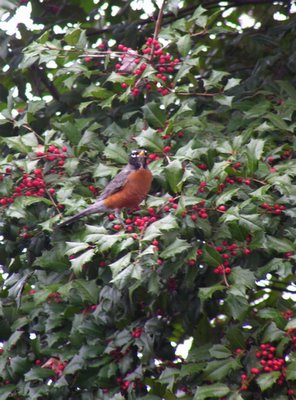
The other day, as Liam and I came out of the public library (always a must when we're in town), we heard the celestial caroling of robins--a huge flock that was feeding in an American holly across the street. Two gifts. First, we're far enough south here in southeast Ohio to even have American hollies. We're the same latitude as D.C., though our winters are colder and snowier, and our summers not quite as hot and humid. But hollies thrive in sheltered places in town, and there are some perfectly magnificent specimens like this fruiting female. Second gift: January robins. Robins singing and choking down holly fruit.
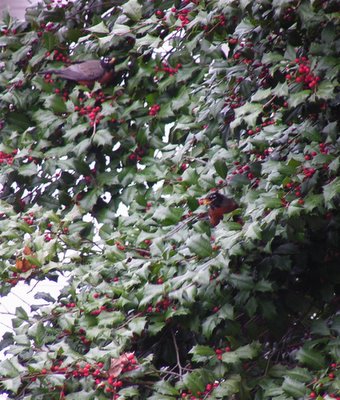 They let me get pretty close with my tiny 10x zoom. I guess that's the third gift. Oh, it was sweet to hear robin song in mid-January, even as the rain pelted down.
They let me get pretty close with my tiny 10x zoom. I guess that's the third gift. Oh, it was sweet to hear robin song in mid-January, even as the rain pelted down.Today, with both kids finally back in school for the day, I'm drawing warblers again for the New York Breeding Bird Atlas. I'm thrilled to be taking part, as the atlas coordinators and steering committee have lined up some terrific artists to illustrate this update of an already monumental work. Old friends like Mike DiGiorgio and John Baumlin, and artists I haven't met but already admire: Alan Messer, Dale Dyer, Sue Adair, Cindy Page and John Wiessinger are all contributing black-and-white illustrations. My dear friends Jim Coe and Barry Van Dusen are painting some color landscapes--surely a first for a breeding bird atlas!
Here's a finished drawing, a female northern parula pulling Cladonia lichen (or reindeer moss) for her hanging nest.
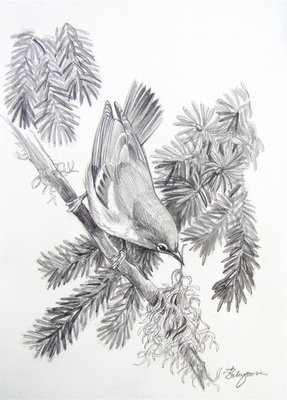 On to the worm-eating warbler. I have it taking a fecal sac from the nest. There are all kinds of ways to confirm breeding birds, and seeing an adult bird with a fecal sac is one of the best. It's ironclad evidence of breeding, as one must hope they only take out their own kids' diapers.
On to the worm-eating warbler. I have it taking a fecal sac from the nest. There are all kinds of ways to confirm breeding birds, and seeing an adult bird with a fecal sac is one of the best. It's ironclad evidence of breeding, as one must hope they only take out their own kids' diapers.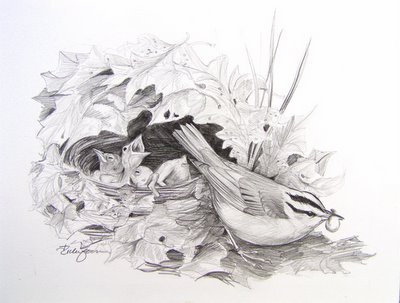 Worm-eating warbler taking fecal sac from nest
Worm-eating warbler taking fecal sac from nestWe've got worm-eating warblers on our southeast-facing slopes. I've only found one nest, back in Connecticut. I watched it from a distance, and the young fledged successfully. The day they left, I crawled up the slope to it, and while examining an infertile egg inside the nest, I noticed that the entire nest seemed to be moving. There was a thick gray mat of bloodthirsty bird mites. Egad. Imagine sitting in THAT for two weeks. They swarmed up my arm and itched like crazy. I really dig drawing nestlings and fledglings. Thanks to lots of experience in rehab, raising baby birds, I feel close to them, and I like making believable drawings of them. (See the worm-eating warbler nestling with stern up, having just delivered the goods?) Too many times, I see artwork of adult birds at the nest, in which the adults are beautifully rendered, but the nestlings are almost like afterthoughts. They're birds, too, and paying close attention to their (admittedly somewhat blobby) anatomy, behavior, and expressions results in a better piece of art.
 Brewster's warbler and hybrid fledgling in black raspberry
Brewster's warbler and hybrid fledgling in black raspberryHere's another drawing, a Brewster's warbler feeding a fledgling. This is a hybrid between blue-winged and golden-winged warblers. Blue-winged warblers are thought to be wreaking the same kind of genetic swamping on golden-wingeds that mallards have on black ducks. Blue-wingeds are more general in their habitat preferences than the fen-loving golden-wingeds, and they're likely to be better competitors, so we're seeing more birds of hybrid parentage and fewer pure golden-wings. We've had a persistently singing Brewster's on our place two years ago. In Connecticut in the '80's, I found a rare Lawrence's (another hybrid of the two pure species) feeding fledglings with a female blue-winged. How I wish I took pictures then! But it's a pleasure to be drawing them now. With its lineup of artists, New York's breeding bird atlas is going to be a heck of a beautiful book. It's a thrill to be part of it.
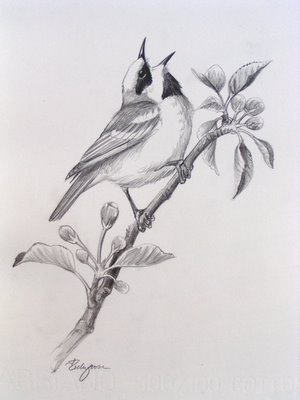 Lawrence's warbler on apple
Lawrence's warbler on apple






0 comments:
Post a Comment